Genre: Sports Developer: Lorisiel Publisher: Tengen Players: 1-2 Released: 1993
Few genres in the world of video games evolve at the rate and degree as that of sports. Annually, dozens of fresh titles swoop into the market to vie for our time, our money, and our sliver of the great pie that is mindshare. Some are simply updated versions of previous releases geared to fuel the zealotry of a dedicated fan base, others are dramatically retooled to attract a larger chunk of the gaming demographic (such as the Wii’s brilliantly bold Pro Evolution Soccer 2008), and a brave few make their debut to challenge incumbent competition. Each year’s influx piggybacks the former, outshining the now-outdated effort. The procession cycles onward as developers become ever better at approximating the sports upon which they base their products. In light of this momentum, the prospect of revisiting a tennis game fifteen years after its release may seem intimidatingly stale. Fortunately for us, then, the game in question is the largely excellent Davis Cup World Tour.
But it’s got one great fault that nearly crushes its promise: ridiculously steep difficulty. This game is brutal. Not simply tough and not just tricky: it’s plain cheap. Rather than presenting a challenge that gradually stiffens as the player hones his skills and masters the controls, Davis Cup confronts you with impenetrable opposition that does its utmost to sully any interest you may have in playing through the game’s bevy of single-player offerings. All the gameplay modes you’d expect to find in a top tier tennis title are present and correct but, alas, no amount of effort committed to learning the fundamentals in any of the five available training modes can prepare you for the ensuing beat down. Even with variable difficulty settings, including the least taxing “beginner” option that oddly removes the ability to manipulate your player’s position on the court, Davis Cup’s fighting spirit never becomes a complimentary asset to gameplay. Besting the computer usually boils down to simply withstanding a rain of abuse long enough for it to botch a return in often the most brain-dead of manners. Squaring off against the CPU never becomes more than a dogged exercise in frustration and exhaustion – not fun.
And yet, despite the debilitating difficulty, this cart manages to come out a winner. The ace up its sleeve? Why, multi-player, of course. Competing with or against a human by your side, rather than loathsome artificial intelligence, really levels the playing field; removes the bitter exterior giving way to the game’s sweet center. It’s together among friends that Davis Cup World Tour takes its true shape. The following assessment, therefore, unfolds with focus on the game’s value as a strictly multi-player affair.
Thanks in no small part to the utter deliciousness of our black beauty’s peerless (to this day) directional pad, Davis Cup World Tour handles like a champ. Control is crisp and responsive at the command of your whim. Fantastic since the game’s lightning-fast arcade-style gameplay celebrates the most dexterous of twitchy thumbs. To this end, you’re given a selection of six distinct shots, each triggered by pressing the correspondent input on your six-button game pad. Say what?! Not a problem (though you really should have one, if only for Ranger X), your three buttons serve double duty: each is assigned an alternate function that’s triggered by simultaneously holding down on the d-pad and you’re A, B, or C of choice. Not as elegant, but it works. Of course, six different ways to swing your racquet may seem a bit unnecessary – as in practice it often proves – but the suite speaks volumes of developer Loriciel’s commitment to creating the most comprehensive tennis experience to which our machine had yet played host. Mission accomplished.
The impact of this commitment on the game’s visual presentation runs deep. Detail abounds as players zip across the court subtly scaling in size as they approach and withdraw from the net. Linesmen and ball boys punctuate action with reactive animations that underscore match parameters. Players are seen arguing the legitimacy of the umpire’s judgment in a picture-in-picture display. Speech bubbles occasionally burst above player’s heads pronouncing feelings of anger or elation over the ball’s fate, mirroring your own with uncanny frequency. The courts – indoor, hard, clay, and grass – shift gracefully in parallax as players scuttle toward the yellow blur throughout the course of play. It’s all quite impressive.
But perhaps most striking and certainly most significant of its presentational achievements is the horizontal divide presenting action from the vantage point of two simultaneously opposing players. That’s right, split-screen. Forgoing its contemporaries’ traditional ¾ overhead outlook, Davis Cup World Tour effectively displays two courts at once, giving each side of the net an ideal view of the proceedings. Granting gamers the ability to play the field from a consistent perspective, instead of forcing awkward transposition at the end of sets between top and bottom baselines, allows them to sharpen their skills without concerns of positional disadvantage. Slowdown-free split-screen multi-player, though limited to two, proves the masterstroke that hoists Davis Cup World Tour above its half-baked single-player experience and indeed the bulk of its 16-bit competition.
It’s important to note, though, that the game’s on-court camera is situated much closer to the ground than in the average tennis game and, therefore, conjures a learning curve all its own: view of the ball is sometimes obstructed by players themselves. This is an entirely new dilemma. With practice you’ll be volleying like a pro but getting the hang of this unfamiliar issue does irritate at the outset. What’s more, the tear separating the screen tends to obscure view of high-pitched lob shots; though a bit troublesome, an animated shadow tracking the ball’s movement adequately compensates – it won’t hinder your game for long. There are other graphical blemishes that in no way affect gameplay and, as such, require no further explanation.
Also requiring little explanation is Davis Cup’s audio package; there’s just not much to it. Though perfectly functional, the rather subdued music and no-frills sound effects convey an air of sobriety that, while perhaps in keeping with the elegant simplicity of tennis, belies the arcade-orientation of the game’s mechanics. Slightly disjointed but no big whoop.
At the end of the day the question, of course, is one of relevance. In light of today’s shiny new tennis wares, does Davis Cup World Tour still have what it takes to satiate your hit-the-ball-over-here-and-I’ll-bounce-it-back-your-way cravings? Honestly, I doubt it. With the advent of analog input devices and online connectivity, you’re better off sticking with Virtua Tennis 3. But, within the context of the 16-bit era, it holds its own among the very best and unquestionably deserves your attention. And, in particular regard to the old school SEGA aficionado, well, it should already be in your collection.
SCORE: 8 out of 10


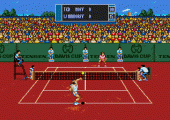
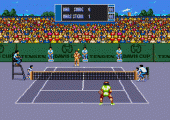
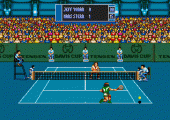
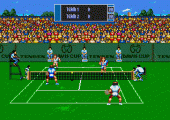
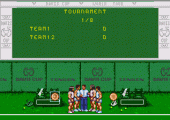
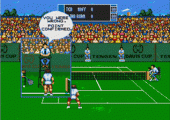
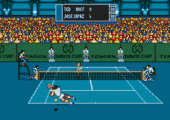
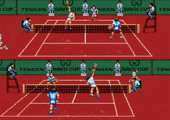
Recent Comments